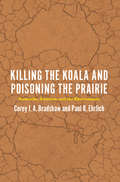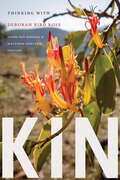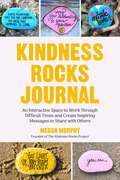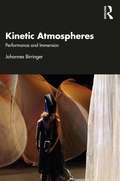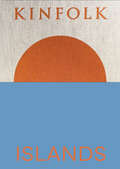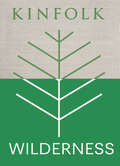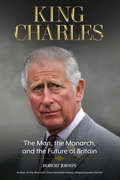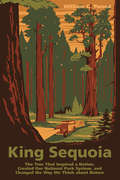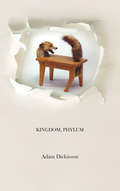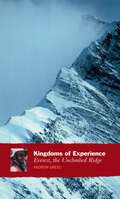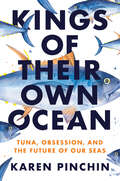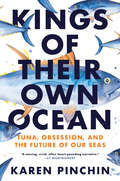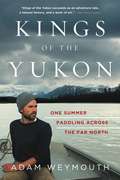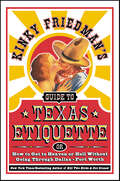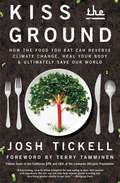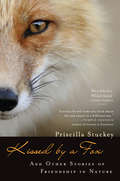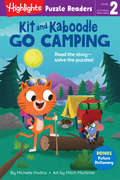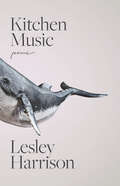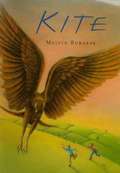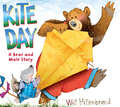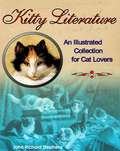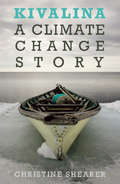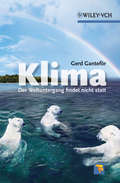- Table View
- List View
Killing the Koala and Poisoning the Prairie: Australia, America, and the Environment
by Paul R. Ehrlich Corey J. BradshawThough separated by thousands of miles, the United States and Australia have much in common. Geographically both countries are expansive—the United States is the fourth largest in land mass and Australia the sixth—and both possess a vast amount of natural biodiversity. At the same time, both nations are on a crash course toward environmental destruction. Highly developed super consumers with enormous energy footprints and high rates of greenhouse-gas emissions, they are two of the biggest drivers of climate change per capita. As renowned ecologists Corey J. A. Bradshaw and Paul R. Ehrlich make clear in Killing the Koala and Poisoning the Prairie, both of these countries must confront the urgent question of how to stem this devastation and turn back from the brink. In this book, Bradshaw and Ehrlich provide a spirited exploration of the ways in which the United States and Australia can learn from their shared problems and combine their most successful solutions in order to find and develop new resources, lower energy consumption and waste, and grapple with the dynamic effects of climate change. Peppering the book with humor, irreverence, and extensive scientific knowledge, the authors examine how residents of both countries have irrevocably altered their natural environments, detailing the most pressing ecological issues of our time, including the continuing resource depletion caused by overpopulation. They then turn their discussion to the politics behind the failures of environmental policies in both nations and offer a blueprint for what must be dramatically changed to prevent worsening the environmental crisis. Although focused on two nations, Killing the Koala and Poisoning the Prairie clearly has global implications—the problems facing the United States and Australia are not theirs alone, and the solutions to come will benefit by being crafted in coalition. This book provides a vital opportunity to learn from both countries’ leading environmental thinkers and to heed their call for a way forward together.
Kin: Thinking with Deborah Bird Rose
by Thom van Dooren and Matthew ChrulewThe contributors to Kin draw on the work of anthropologist Deborah Bird Rose (1946–2018), a foundational voice in environmental humanities, to examine the relationships of interdependence and obligation between human and nonhuman lives. Through a close engagement over many decades with the Aboriginal communities of Yarralin and Lingara in northern Australia, Rose’s work explored possibilities for entangled forms of social and environmental justice. She sought to bring the insights of her Indigenous teachers into dialogue with the humanities and the natural sciences to describe and passionately advocate for a world of kin grounded in a profound sense of the connectivities and relationships that hold us together. Kin’s contributors take up Rose’s conceptual frameworks, often pushing academic fields beyond their traditional objects and methods of study. Together, the essays do more than pay tribute to Rose’s scholarship; they extend her ideas and underscore her ongoing critical and ethical relevance for a world still enduring and resisting ecocide and genocide.Contributors. The Bawaka Collective, Matthew Chrulew, Colin Dayan, Linda Payi Ford, Donna Haraway, James Hatley, Owain Jones, Stephen Muecke, Kate Rigby, Catriona (Cate) Sandilands, Isabelle Stengers, Anna Tsing, Thom van Dooren, Kate Wright
Kindness Rocks Journal: An Interactive Space to Work Through Difficult Times and Create Inspiring Messages to Share with Others
by Megan Murphy#1 New Release in Rocks & Minerals — The Kindness Rocks Project, in Journal FormFans of Start with Gratitude, The Kindness Challenge and the Chicken Soup for the Soul books will love the Kindness Rocks Journal.A rock for each kindness: It all started with a single stone on a beach in Cape Cod and now spans the globe. The Kindness Rocks Project, founded by Megan Murphy, author of A Pebble for Your Thoughts, is based on the profound truth that one kind message at the right moment can change someone’s day, their outlook, and their whole life. This rock painting project has become an international grassroots movement! The messages on these positivity pebbles take many forms: gratitude, affirmations, encouragement, offers of hope—all signposts along the way for someone to find at exactly the right time.A Kindness and Gratitude Journal: Now more than ever, people are longing for kindness and connection. During these uncertain times, daily news reports focus on disturbing events of terrorism, gun violence, senseless murders, and political bickering. We are bombarded with images that evoke fear and hostility. The Kindness Rocks Journal provides a space to create a positive counteraction to all this negativity.Learn to be kinder to yourself and others: Sometimes, all it takes is just one simple positive message to change your perspective, and that is what this interactive writing journal aims to help you do.In the Kindness Rocks Journal, you will have space to:Respond to helpful journal prompts, affirmations, and quotesGrow through hard times with kindness and joyLearn how to paint an inspirational Kindness Rock and share it with others
Kinetic Atmospheres: Performance and Immersion
by Johannes BirringerThis book offers a sustained and deeply experiential pragmatic study of performance environments, here defined at unstable, emerging, and multisensational atmospheres, open to interactions and travels in augmented virtualities. Birringer’s writings challenge common assumptions about embodiment and the digital, exploring and refining artistic research into physical movement behavior, gesture, sensing perception, cognition, and trans-sensory hallucination. If landscapes are autobiographical, and atmospheres prompt us to enter blurred lines of a "forest knowledge," where light, shade, and darkness entangle us in foraging mediations of contaminated diversity, then such sensitization to elemental environments requires a focus on processual interaction. Provocative chapters probe various types of performance scenarios and immersive architectures of the real and the virtual. They break new ground in analyzing an extended choreographic – the building of hypersensorial scenographies that include a range of materialities as well as bodily and metabodily presences. Foregrounding his notion of kinetic atmospheres, the author intimates a technosomatic theory of dance, performance, and ritual processes, while engaging in a vivid cross-cultural dialogue with some of the leading digital and theatrical artists worldwide. This poetic meditation will be of great interest to students and scholars in theatre, performing arts as well as media arts practitioners, composers, programmers, and designers.
Kinfolk Islands (Kinfolk Adventures)
by John Burns&“Wanderlust inspiration.&”—GQ, The Best Gifts for Coworkers Join Kinfolk on a journey off the beaten track, to islands big and small, in this collection of eighteen new travel stories. Whether it&’s a tour of the otherworldly landscape of Socotra in Yemen or a hike into the old growth of a Japanese forest on Yakushima, each slow travel itinerary invites you to set sail at a pace that allows for true discovery and immersion. Filled with ideas and inspiration for where to escape, explore and unwind, Kinfolk Islands is full of vibrant photography, practical guidance and thoughtful reflections on why the idea of an island embodies so many of our travel fantasies. There are the charms of urban islands, including Montréal&’s beloved Mile End neighborhood. Truly unexpected destinations, like Hormuz, off the coast of Iran, with its psychedelic scenery and bohemian spirit. Italy&’s sun-soaked Ponza, perfect for languid afternoons. And of course some of the world&’s most beautiful beaches, from jungle-fringed Caribbean sands to rugged and remote Nordic shores. Believing that travel is as much a state of mind as an action or itinerary, Kinfolk celebrates a way of exploring our world that not only fosters thoughtful perspectives on the places we visit but also deepens our relationship with home once the journey is over.
Kinfolk Wilderness (Kinfolk Adventures)
by John BurnsThe second volume in the new Kinfolk trilogy (following Kinfolk Islands), which invites readers to celebrate the beauty and possibility to be found in the great outdoors.
King Charles: The Man, the Monarch, and the Future of Britain
by Robert JobsonAn exhaustive and revealing biography of Britain&’s new monarch, King Charles III, with fresh reporting by the journalist the Wall Street Journal dubbed &“the Godfather of royal reporting.&” With exclusive interviews and extensive research, King Charles delivers definitive insight into the extraordinary life of His Royal Highness, former Prince of Wales, as he takes the throne, a watershed moment in modern history and in the British monarchy.New York Times bestselling author Robert Jobson debunks the myths about the man who became king, going beyond banal, bogus media caricatures of Charles to tell his true story. Jobson—who has spent nearly thirty years chronicling the House of Windsor, and has met Charles on countless occasions—received unprecedented cooperation from Clarence House, what was the Prince&’s office, in writing this illuminating biography.King Charles divulges the full range of Charles&’s profoundly held political beliefs: the United Kingdom&’s special relationship to the United States, climate change, Brexit, and immigration—to ultimately portray the kind of monarch Charles III will be. Jobson taps a number of sources close to the now-King who have never spoken on the record before, plus members of the Royal Household who have served Charles during his decades of public life. This comprehensive profile also reveals the late Queen Elizabeth&’s plans to transition Charles to the throne; how at her insistence he already reads all government briefings; and why he feels it is his constitutional duty to relay his thoughts to ministers in his controversial &“black spider memos.&” Moreover, King Charles reveals the truth about Charles's deeply loving but occasionally volatile relationship with his second wife and chief supporter, Camilla. The result is an intriguing new portrait of a man who at last has become king.
King Sequoia: The Tree That Inspired a Nation, Created Our National Park System, and Changed the Way We Think about Nature (The Story Behind the Scenery Ser.)
by William TweedFrom a towering tree, one of California's preeminent naturalists unspools a history that echoes across generations and continents. Former park ranger William C. Tweed takes readers on a tour of the Big Trees in a narrative that travels deep into the Sierras, around the West, and all the way to New Zealand; and in doing so he explores the American public's evolving relationship with sequoias. It comes as no surprise that the groves in Yosemite and Calaveras were early tourist destinations, as this species that predated Christ and loomed over all the world's other trees was the embodiment of California's superlative, almost unbelievable appeal. When sequoias were threatened by logging interests, the feelings of horror that this desecration evoked in people catalyzed protection efforts; in a very direct way, this species inspired the Park Idea. And sequoias' influence doesn't end there: as science evolved to consider landscapes more holistically, sequoias were once again at the heart of this attitudinal shift. Featuring an entrancing cast of adventurers, researchers, politicians, and environmentalists, King Sequoia reveals how one tree species has transformed Americans' connection to the natural world.
King Sequoia: The Tree That Inspired a Nation, Created Our National Park System, and Changed the Way We Think about Nature (The\story Behind The Scenery Ser.)
by William C. TweedA naturist and historian for the National Parks Service offers a lively history of the giant sequoias of California and the love of nature they inspired. Former park ranger William C. Tweed takes readers on a tour of some of the world&’s largest and oldest trees in a narrative that travels deep into the Sierra Nevada mountains, across the American West, and all the way to New Zealand. Along the way, he explores the American public's evolving relationship with sequoias, also known simply and affectionately as Big Trees. It&’s no surprise that the sequoia groves of Yosemite and Calaveras were early tourist destinations. The species was the embodiment of California's superlative appeal. These giant redwoods were so beloved that special protections efforts sprang up to protect them from logging interests—and so began the notion of National Parks. Later, as science evolved to consider landscapes more holistically, sequoias once again played a major role in shaping this new perspective. Featuring a fascinating cast of adventurers, researchers, politicians, and environmentalists, King Sequoia reveals how one tree species transformed Americans' connection to the natural world.
Kingdom, Phylum
by Adam DickinsonShortlisted for the 2007 Trillium Book Award for Poetry Ecologically aware poems, hardwired to the intellect and the heart in equal measure. Adam Dickinson's poems, with firm intellectual bite and imaginative scope, reach fresh levels of poetic -- and ecological -- awareness. Sometimes reminiscent of Wallace Stevens, sometimes of Christopher Dewdney, and with the ghost of Foucault always in attendance, they ply a language that is cool and precise on the surface to open into the deep resonance of geologic time. Imaginative and contemplative, this writing is bound to refresh the vision of the most world-weary reader. The poems in Kingdom, Phylum push the boundaries of thought and language. Bringing lyrical and unsystematic modes of understanding into play, and keeping his ear tuned to the many disruptions involved in taxonomical arrangement, Dickinson shows how poetry both participates in, and unsettles, the provisional orders which develop between word and world.
Kingdoms of Experience: Everest, the Unclimbed Ridge
by Andrew GreigA novice&’s tale of scaling Everest: &“Recommended for all armchair adventurers who have ever wondered what it would be like to climb in the Himalayas.&”—Geographical Magazine The last attempt to conquer Everest by the unclimbed northeast ridge had ended in failure and tragedy, with the deaths of two great climbers, Joe Tasker and Pete Boardman. Now, in March 1985, Mal Duff would lead a new expedition. Andrew Grieg and the others knew the risks as well as the excitement of the challenge—and in this extraordinary book, Greig chronicles not only the assault on the peak but also the complex relationships of nineteen very different personalities living together. &“Poet, novelist, and novice climber Greig's insightful account of the 1985 ascent of Everest's previously unclimbed northeast ridge provides an unusual perspective on the world of climbing. In comparison to many seasoned mountaineers, with their sometimes obsessive &‘diehard&’ drive, Greig possesses a refreshing sense of enthusiasm and innocence. His lack of experience allows him to describe with great intensity and detail the difficult tasks of climbing in a methodical step-by-step fashion, allowing readers to grasp the complex challenges. Greig is often able to step back and observe the goings-on, providing a detached analysis of the group and its dynamics. To complement his version of events, he also draws liberally from the diaries of the other participants. A unique addition to mountaineering literature with charming and distinct characteristics.&”—Library Journal
Kings of Their Own Ocean: Tuna, Obsession, and the Future of Our Seas
by Karen PinchinThis is a tale of human obsession, one intrepid tuna, the dedicated fisherman who caught and set her free, the promises and limits of ocean science, and the big truth of how our insatiable appetite for bluefin transformed a cottage industry into a global dilemma. In 2004, an enigmatic charter captain named Al Anderson caught and marked one Atlantic bluefin tuna off New England&’s coast with a plastic fish tag. Fourteen years later that fish—dubbed Amelia for her ocean-spanning journeys—died in a Mediterranean fish trap, sparking Karen Pinchin&’s riveting investigation into the marvels, struggles, and prehistoric legacy of this remarkable species. Over his fishing career Al marked more than sixty thousand fish with plastic tags, an obsession that made him nearly as many enemies as it did friends. His quest landed him in the crossfire of an ongoing fight between a booming bluefin tuna industry and desperate conservation efforts, a conflict that is once again heating up as overfishing and climate change threaten the fish&’s fate.Kings of Their Own Ocean is an urgent investigation that combines science, business, crime, and environmental justice. As Pinchin writes, &“as a global community, we are collectively only ever a few terrible choices away from wiping out any ocean species.&” Through her exclusive access and interdisciplinary, mesmerizing lens, readers will join her on boats and docks as she visits tuna hot spots and scientists from Portugal to Japan, New Jersey to Nova Scotia, and glimpse, as the author does, rays of dazzling hope for the future of our oceans.
Kings of Their Own Ocean: Tuna, Obsession, and the Future of Our Seas
by Karen PinchinThe marvelous tale of one fish, the fisherman who first caught her, and how our insatiable appetite for bluefin tuna turned a cottage industry into a massive global dilemma.In 2004, an enigmatic charter captain named Al Anderson caught and tagged one Atlantic bluefin tuna off New England's coast. Fourteen years later that same fish—dubbed Amelia for her ocean-spanning journeys—was caught again, this time in a Mediterranean fish trap. Over his fishing career, Al marked more than sixty thousand fish with plastic tags, an obsession that made him nearly as many enemies as it did friends. His quest landed him in the crossfire of an ongoing fight between a booming bluefin tuna industry and desperate conservation efforts, a conflict that is once again heating up as overfishing and climate change threaten the fish's fate.Kings of Their Own Ocean is an urgent investigation that combines science, business, crime, and environmental justice. Through Karen Pinchin's exclusive interviews and access, interdisciplinary approach, and mesmerizing storytelling, readers join her on boats and docks as she visits tuna hot spots and scientists from Portugal to Japan, New Jersey to Nova Scotia, and glimpse, as Pinchin does, rays of dazzling hope for the future of our oceans.
Kings of the Yukon: One Summer Paddling Across the Far North
by Adam Weymouth"Stirring and heartbreaking." - David Owen, author of Where the Water GoesOne man's thrilling and transporting journey by canoe across Alaska in search of the king salmonThe Yukon river is 2,000 miles long, the longest stretch of free-flowing river in the United States. In this riveting examination of one of the last wild places on earth, Adam Weymouth canoes along the river's length, from Canada's Yukon Territory, through Alaska, to the Bering Sea. The result is a book that shows how even the most remote wilderness is affected by the same forces reshaping the rest of the planet. Every summer, hundreds of thousands of king salmon migrate the distance of the Yukon to their spawning grounds, where they breed and die, in what is the longest salmon run in the world. For the communities that live along the river, salmon was once the lifeblood of the economy and local culture. But climate change and a globalized economy have fundamentally altered the balance between man and nature; the health and numbers of king salmon are in question, as is the fate of the communities that depend on them. Traveling along the Yukon as the salmon migrate, a four-month journey through untrammeled landscape, Adam Weymouth traces the fundamental interconnectedness of people and fish through searing and unforgettable portraits of the individuals he encounters. He offers a powerful, nuanced glimpse into indigenous cultures, and into our ever-complicated relationship with the natural world. Weaving in the rich history of salmon across time as well as the science behind their mysterious life cycle, Kings of the Yukon is extraordinary adventure and nature writing at its most urgent and poetic.
Kinky Friedman's Guide to Texas Etiquette: Or How to Get to Heaven or Hell Without Going Through Dallas-Fort Worth
by Kinky FriedmanWell, butter my butt and call me a biscuit! Delivering belly laughs, hee-haws, and downright slackjaw amazement, this hilarious guide to the homeland of George W. and Willie Nelson is the essential how-to for surviving in the Lone Star State. From strange Texas laws and the history of Dr. Pepper to "Texas Talk" (in which a "turd floater" is a heavy downpour) and final-meal requests by death row inmates, Kinky Friedman, "the oldest living Jew in Texas who doesn't own any real estate," provides an insider's guide that will be loved by native Texans and the rest of us poor devils alike.Even if you don't know the difference between an Aggie and an armadillo -- or what's really in the back on Willie Nelson's tour bus -- you can pass for a Texan with the Kinkster's expert coaching. So grab your hairspray and the keys to the Cadillac and get reading!
Kiss the Ground: How the Food You Eat Can Reverse Climate Change, Heal Your Body & Ultimately Save Our World
by Josh TickellFrom Josh Tickell, one of America&’s most celebrated documentary filmmakers, comes a &“fascinating, easy-to-follow blueprint for how eating in ways that nourish and regenerate the soil can not only help reverse global warming, but also bring greater vitality to our lives&” (Wolfgang Puck). &“A must read for anyone committed to healing our bodies and our Earth&” (Deepak Chopra), Kiss the Ground explains an incredible truth: by changing our diets to a soil-nourishing, regenerative agriculture diet, we can reverse global warming, harvest healthy, abundant food, and eliminate the poisonous substances that are harming our children, pets, bodies, and ultimately our planet. This &“richly visual&” (Kirkus Reviews) look at the impact of an underappreciated but essential resource—the very ground that feeds us—features fascinating and accessible interviews with celebrity chefs, ranchers, farmers, and top scientists. Kiss the Ground teaches you how to become an agent in humanity&’s single most important and time-sensitive mission: reverse climate change and effectively save the world—all through the choices you make in how and what to eat. Also a full-length documentary executive produced by Leonardo DiCaprio and narrated by Woody Harrelson, &“Kiss the Ground both informs and inspires&” (Marianne Williamson, #1 New York Times bestselling author).
Kissed by a Fox: And Other Stories of Friendship in Nature
by Priscilla Stuckey"Dissatisfaction with nature flows throughout Western civilization, as deep as its blood, as abiding as its bones. Convinced to the marrow that something is deeply wrong with nature, . . . the Western world tries to remake it into something better."For Priscilla Stuckey, this is a fundamental and heartbreaking misconception: that nature can be fixed, exploited, or simply ignored. Modern societies try to bend nature to human will instead of engaging in give-and-take with a living, breathing land community.Using her personal experiences as the cornerstone, Stuckey explores the depth of relationship possible with the birch tree in our backyard, the nearby urban creek, the dog who settles on our bed each night.Drawing inspiration from sources as varied as ancient philosophers and contemporary biologists, Stuckey challenges readers to enact a different story of nature, one in which people and place are not separate, where other creatures respond to human need, and where humans and all others together create the world.With the eloquence of the great nature writers before her, Stuckey encourages us to open ourselves to the unlimited possibilities of a truly connected life.
Kit and Kaboodle Go Camping (Highlights Puzzle Readers)
by Michelle PorticeStories + Puzzles = Reading Success! Highlights Puzzle Readers offer an innovative approach to learning to read that integrates puzzles and stories to develop motivated, confident readers.Hit the trail as Kit and Kaboodle head up a mountain on their camping trip in this Level 2 Highlights Puzzle Reader. Kids can help the duo by finding items for their journey in six Hidden Pictures puzzles that double as story illustrations. With a bonus picture dictionary, Kit and Kaboodle Go Camping is perfect for readers who are starting to explore reading.National Parenting Seal of ApprovalWinner, National Parenting Product Award (NAPPA)
Kitchen Music
by Lesley HarrisonA cosmology of place written in the songs of whales and birds, folk tales, city streets, and the green glass sea In her first book-length collection of poems to appear in the US, Lesley Harrison looks North to the sea, with the heat of the land at her back, to bring us meditations on whale hunts and lost children, Manhattan sky towers, and the sound of the gamelan in the Gulf of Bothnia. A poetry of spareness in multilayered depths, of textural silence and aural place, Kitchen Music plunges deep through the strata of language where “weather is body” and an Iceland poppy is “as delicate as birch.” In poems and sequences of poems, Harrison spins folktales into threads of family and gender, engages with the work of the artists Roni Horn and Marina Rees, transcribes John Cage and Johannes Kepler into song and litany, pens a hymnal of bees, and turns to storms, glaciers, and the lapwing life in a field of young barley. As the novelist Kirsty Gunn writes in the foreword, Harrison has “taken up the old white whale of the fixed and masculine narratives and made of its seas and weathers her own Moby Dick, a female poetry ‘in praises / repeated, repeating.’”
Kite
by Melvin BurgessTaylor loves birds and collects eggs. He has the rare opportunity to enhance his collection when a pair of red kites nest nearby. The only problem is, the red kites are extremely rare -- only twenty-five are left in the country. Taylor's father, a gamekeeper, is under orders from his boss, the landowner Reg Harris, to kill the kites, who are birds of prey and will go after Harris's grouse population. For Taylor, the temptation also to take the eggs from the kites' nest becomes insurmountable when Harris actually asks him to do the job, even though it is illegal. Pangs of terrible guilt follow, and although Taylor tells Harris he's gotten rid of the incriminating evidence, he secretly salvages and hatches one egg. But as soon as the bird is born, elaborate plans must be made to keep its existence a secret in order to save it from being shot during the approaching hunting season.
Kite Day: A Bear and Mole Story (Bear and Mole #2)
by Will HillenbrandOn a windy spring day, Bear sniffs the air. Could it be. . . Kite day? Rushing home he tells Mole, and the two fast friends get to work building a kite of their own. They study, and collect, and measure, and construct—and soon, their kite is flying high above the meadow. But when a storm rumbles in—SNAP!—the kite string breaks, and all their hard work soars away. Chasing after it, Mole and Bear discover all is not lost—wedged in the branches of a tree, their kite protects a nest of baby birds from the pouring rain. Will Hillenbrand's Bear and Mole series is the perfect choice for storytime sharing or reading aloud. Strong verbs, repetitive phrases, and fun-to-read sounds keep young listeners and readers engaged with the story, while the gentle illustrations add detail and quiet humor. Kids will delight in poring over these books again and again. Don't miss the other Bear and Mole titles, including All For a Dime, Spring is Here, and First Star!
Kitty Literature: An Illustrated Collection for Cat Lovers
by William Shakespeare L. Frank Baum Rudyard Kipling Miguel De Cervantes Edgar Allan Poe Charles Darwin Emily Dickinson Mark Twain Charles Dickens Louisa May Alcott Alexandre Dumas Lewis Carroll Henry David Thoreau Oscar Wilde John Greenleaf Whittier Sir Walter Scott Washington Irving Anton Chekhov Lafcadio Hearn Beatrix Potter John Keats Bram Stoker P. G. Wodehouse Harriet Beecher Stowe H. P. Lovecraft Carl Sandburg E. E. Cummings John Muir Leonardo Da Vinci William Wordsworth W. B. Yeats Charles Baudelaire William Carlos Williams The Brothers Grimm Percy Bysshe Shelley John Richard Stephens Arthur Rackham Vincent Van Gogh John James Audubon Paul Gauguin Pierre Bonnard Francisco José de Goya y Lucientes Teddy Roosevelt Louis Wain Samuel F. B. Morse Goya Marc Chagall Ando Hiroshige Pierre-Auguste Renoir Pablo Picasso Thomas Eakins Henri RousseauPeople have been fascinated by cats for centuries. From the ancient Egyptians, all the way down to today's cat lovers throughout the world, cats have held a special place in people's lives. Cats are unique creatures. It shouldn't be surprising that they have captured the imaginations of many of the world's greatest authors and artists.This book contains 242 illustrations selected from the world's best cat art by 58 great artists, and explores stories, poetry, essays and quotations on cats by 37 of the most acclaimed and classic writers.From Beatrix Potter to Louisa May Alcott to Teddy Roosevelt, this eclectic collection features writings about cats by such great masters as Dickens, Kipling, Chekhov, Poe, Lovecraft, Keats, Shelley, Yeats, Whittier, Audubon, Muir, Thoreau, and Mark Twain, accompanied by fine art museum pieces by Renoir, da Vinci, van Gogh, Rousseau, Hiroshige, Goya, Chagall, Gauguin, and Picasso.Kitty Literature is perfect for anyone who lives with one or more cats. It will also make an excellent gift book.(321 pages, 242 illustrations)
Kitty Literature: An Illustrated Collection for Cat Lovers
by William Shakespeare L. Frank Baum Rudyard Kipling Miguel De Cervantes Edgar Allan Poe Charles Darwin Emily Dickinson Mark Twain Charles Dickens Louisa May Alcott Alexandre Dumas Lewis Carroll Henry David Thoreau Oscar Wilde John Greenleaf Whittier Sir Walter Scott Washington Irving Anton Chekhov Lafcadio Hearn Beatrix Potter John Keats Bram Stoker Harriet Beecher Stowe H. P. Lovecraft Carl Sandburg E. E. Cummings John Muir Leonardo Da Vinci William Wordsworth W. B. Yeats Charles Baudelaire William Carlos Williams The Brothers Grimm Percy Bysshe Shelley John Richard Stephens Arthur Rackham Vincent Van Gogh John James Audubon Paul Gauguin Francisco José de Goya y Lucientes Teddy Roosevelt Louis Wain Samuel F. B. Morse Goya Ando Hiroshige Pierre-Auguste Renoir Thomas Eakins Henri RousseauPeople have been fascinated by cats for centuries. From the ancient Egyptians, all the way down to today's cat lovers throughout the world, cats have held a special place in people's lives. Cats are unique creatures. It shouldn't be surprising that they have captured the imaginations of many of the world's greatest authors and artists.This book contains 229 illustrations selected from the world's best cat art by 49 great artists, and explores stories, poetry, essays and quotations on cats by 36 of the most acclaimed and classic writers.From Beatrix Potter to Louisa May Alcott to Teddy Roosevelt, this eclectic collection features writings about cats by such great masters as Dickens, Kipling, Chekhov, Poe, Lovecraft, Keats, Shelley, Yeats, Whittier, Audubon, Muir, Thoreau, and Mark Twain, accompanied by fine art museum pieces by Renoir, da Vinci, van Gogh, Rousseau, Hiroshige, Goya, Gauguin, and many others.Kitty Literature is perfect for anyone who lives with one or more cats. It will also make an excellent gift book.(306 pages, 229 illustrations)
Kivalina: A Climate Change Story
by Christine ShearerThe true story of an Alaska Native village destroyed by flooding and erosion caused by climate change—and how they fought for help.Warming Arctic temperatures have been making coastal areas of Alaska increasingly uninhabitable. In 2008, the small Alaska Native village of Kivalina filed a legal claim against some of the world’s largest fossil fuel companies for damaging their homeland and creating a false debate around climate change. Academic and former journalist Christine Shearer explores the history leading up to the lawsuit, its connections to disaster management and adaptation, and its relationship to past misinformation campaigns involving lead, asbestos, and tobacco. Kivalina’s struggle for safe relocation, the book argues, is part of our common struggle to acknowledge and address climate change before it is too late.2012 Rachel Carson Environment Book Award (Honorable Mention)Praise for Kivalina“Moving, infuriating, ominous . . . . Shearer provides an impressively concise and comprehensive history of the growth of corporate power in America; its influence on, entwinement with, and corruption of government; [and] corporate obfuscation of industrial hazards.” —Publisher’s Weekly“Best book of 2011: one of the most timely and important books to be published in 2011—and in the past decade.” —Jeff Biggers, The Huffington Post“In novelistic detail, Shearer recounts the science, politics, legal battles, and human experience at one of the leading edges of climate change impact. In doing so, she . . . tells the story not just of one village in Alaska, but of us all.” —The Society of Environmental Journalists
Klima
by Gerd GanteförPanikmache oder sicheres Weltende? Was vom "Klimawandel" wirklich zu halten istKaum ein Thema erregt die Gemüter so wie die Frage, ob der Klimawandel uns alle ins Verderben stürzt oder wir nur einer Angst fördernden Kampagne hysterischer Umweltaktivisten aufsitzen. Die Diskussionen werden heiß geführt und münden oft in extreme Positionen und widersprüchliche Szenarien. Und eines ist bei alldem selten zu finden: verlässliche Orientierung. Genau diese bietet Gerd Ganteför mit seinem Buch.Orientierung durch WissenGerd Ganteför überprüft die gängigen Argumente, Mythen und Legenden: unabhängig, seriös und wissenschaftlich fundiert. So leistet er nicht nur eminent wichtige Aufklärungsarbeit, sondern fördert auch einige handfeste Überraschungen zu Tage. Der staunende Leser erfährt etwa, dass Flugreisende energieeffizienter unterwegs sind als Autofahrer, und er bekommt eine Vorstellung davon, was die Menschheit bei der nächsten Eiszeit erwartet. Ganz nebenbei vermittelt der Autor dabei fundiertes Wissen zu den zentralen Zukunftsthemen Klima und Energie.Provokation mit ArgumentenGanz bewusst tritt Gerd Ganteför der grassierenden "Lust am Untergang" entgegen. So verweist er auf die Vorteile der Klimaerwärmung, bindet Kohle- und Kernkraftwerke in eine Strategie zum Naturschutz ein und bescheinigt den Verfechtern regenerativer Energien, einem schönen Traum nachzuhängen. Selten sind solche Thesen mit so guten Argumenten vertreten worden wie in diesem Buch.
